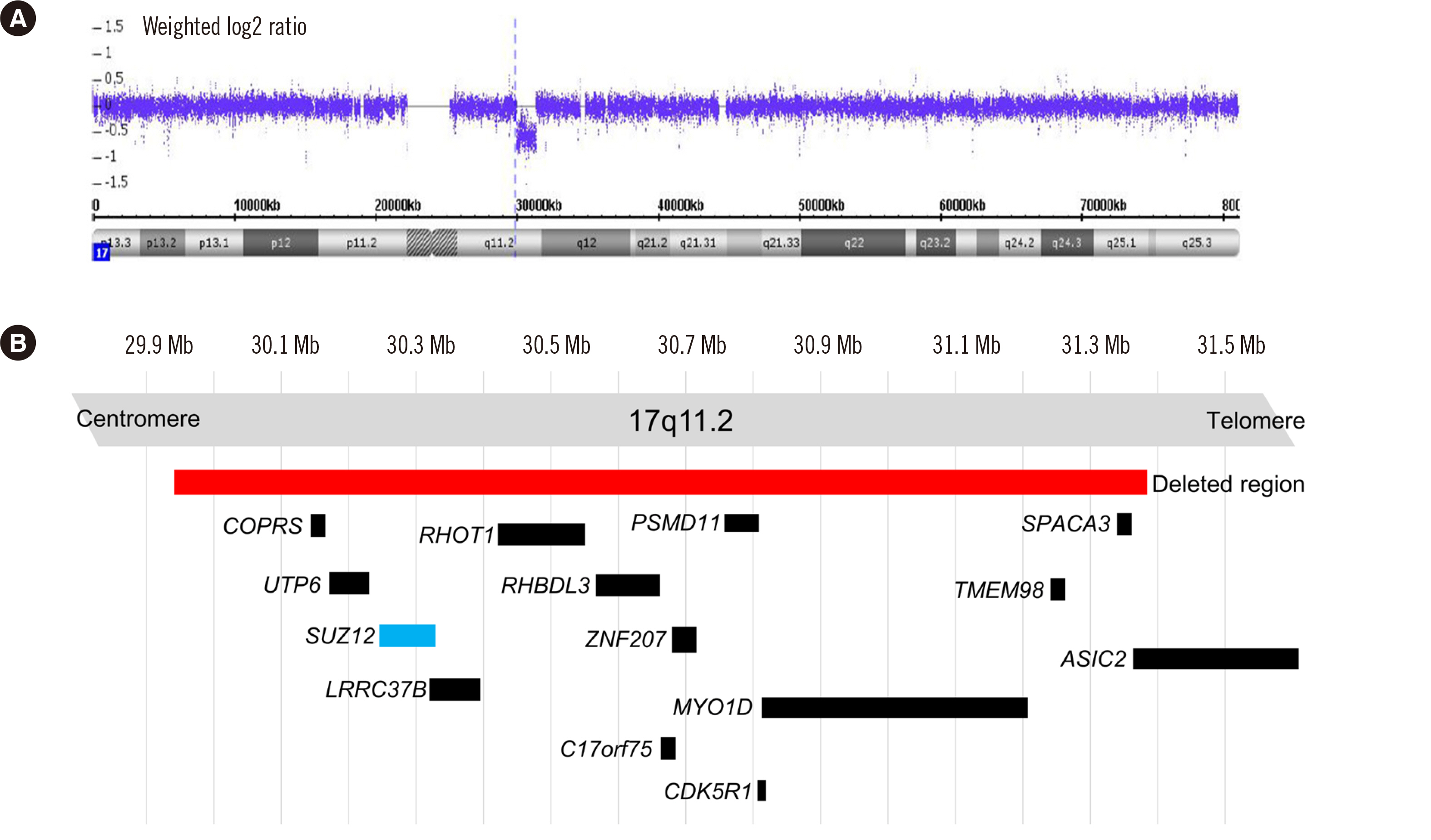Ann Lab Med.
2023 May;43(3):319-322. 10.3343/alm.2023.43.3.319.
Identification of SUZ12 Haploinsufficiency due to a 1.4-Mb Deletion at 17q11.2 in a Child With Overgrowth and Intellectual Disability Syndrome
- Affiliations
-
- 1Departments of Pediatrics, Soonchunhyang University Bucheon Hospital, Soonchunhyang University College of Medicine, Bucheon, Korea
- 2Departments of Laboratory Medicine and Genetics, Soonchunhyang University Bucheon Hospital, Soonchunhyang University College of Medicine, Bucheon, Korea
- KMID: 2551720
- DOI: http://doi.org/10.3343/alm.2023.43.3.319
Figure
Reference
-
1. Margueron R, Reinberg D. 2011; The polycomb complex PRC2 and its mark in life. Nature. 469:343–9. DOI: 10.1038/nature09784. PMID: 21248841. PMCID: PMC3760771.
Article2. Cyrus S, Burkardt D, Weaver DD, Gibson WT. 2019; PRC2-complex related dysfunction in overgrowth syndromes: a review of EZH2, EED, and SUZ12 and their syndromic phenotypes. Am J Med Genet C Semin Med Genet. 181:519–31. DOI: 10.1002/ajmg.c.31754. PMID: 31724824.3. Suri T, Dixit A. 2017; The phenotype of EZH2 haploinsufficiency-1.2-Mb deletion at 7q36.1 in a child with tall stature and intellectual disability. Am J Med Genet A. 173:2731–5. DOI: 10.1002/ajmg.a.38356. PMID: 28696078.4. Imagawa E, Albuquerque EVA, Isidor B, Mitsuhashi S, Mizuguchi T, Miyatake S, et al. 2018; Novel SUZ12 mutations in Weaver-like syndrome. Clin Genet. 94:461–6. DOI: 10.1111/cge.13415. PMID: 30019515.5. Imagawa E, Higashimoto K, Sakai Y, Numakura C, Okamoto N, Matsunaga S, et al. 2017; Mutations in genes encoding polycomb repressive complex 2 subunits cause Weaver syndrome. Hum Mutat. 38:637–48. DOI: 10.1002/humu.23200. PMID: 28229514.
Article6. Cyrus SS, Cohen ASA, Agbahovbe R, Avela K, Yeung KS, Chung BHY, et al. 2019; Rare SUZ12 variants commonly cause an overgrowth phenotype. Am J Med Genet C Semin Med Genet. 181:532–47. DOI: 10.1002/ajmg.c.31748. PMID: 31736240.7. Schuettengruber B, Bourbon HM, Di Croce L, Cavalli G. 2017; Genome regulation by polycomb and trithorax: 70 years and counting. Cell. 171:34–57. DOI: 10.1016/j.cell.2017.08.002. PMID: 28938122.
Article8. Kehrer-Sawatzki H, Wahlländer U, Cooper DN, Mautner VF. 2021; Atypical NF1 microdeletions: challenges and opportunities for genotype/phenotype correlations in patients with large NF1 deletions. Genes (Basel). 12:1639. DOI: 10.3390/genes12101639. PMID: 34681033. PMCID: PMC8535936.
Article9. Pasmant E, Sabbagh A, Spurlock G, Laurendeau I, Grillo E, Hamel MJ, et al. 2010; NF1 microdeletions in neurofibromatosis type 1: from genotype to phenotype. Hum Mutat. 31:E1506–18. DOI: 10.1002/humu.21271. PMID: 20513137.10. Genome Aggregation Database (gnomAD v2.1.1). http://gnomad.broadinstitute.org. Updated on Aug 2022.
- Full Text Links
- Actions
-
Cited
- CITED
-
- Close
- Share
- Similar articles
-
- Diagnostic Evaluation and Rehabilitation in Children with Intellectual Disabilities
- Genetic syndromes associated with overgrowth in childhood
- The First Cases of OPHN1 Exons 1 and 2 Deletion in Two X-linked Intellectual Developmental Disorder Patients in Korea
- Reciprocal Deletion and Duplication of 17p11.2-11.2: Korean Patients with Smith-Magenis Syndrome and Potocki-Lupski Syndrome
- A Case of De Novo 18p Deletion Syndrome with SensorineuralHearing Loss: A case report


